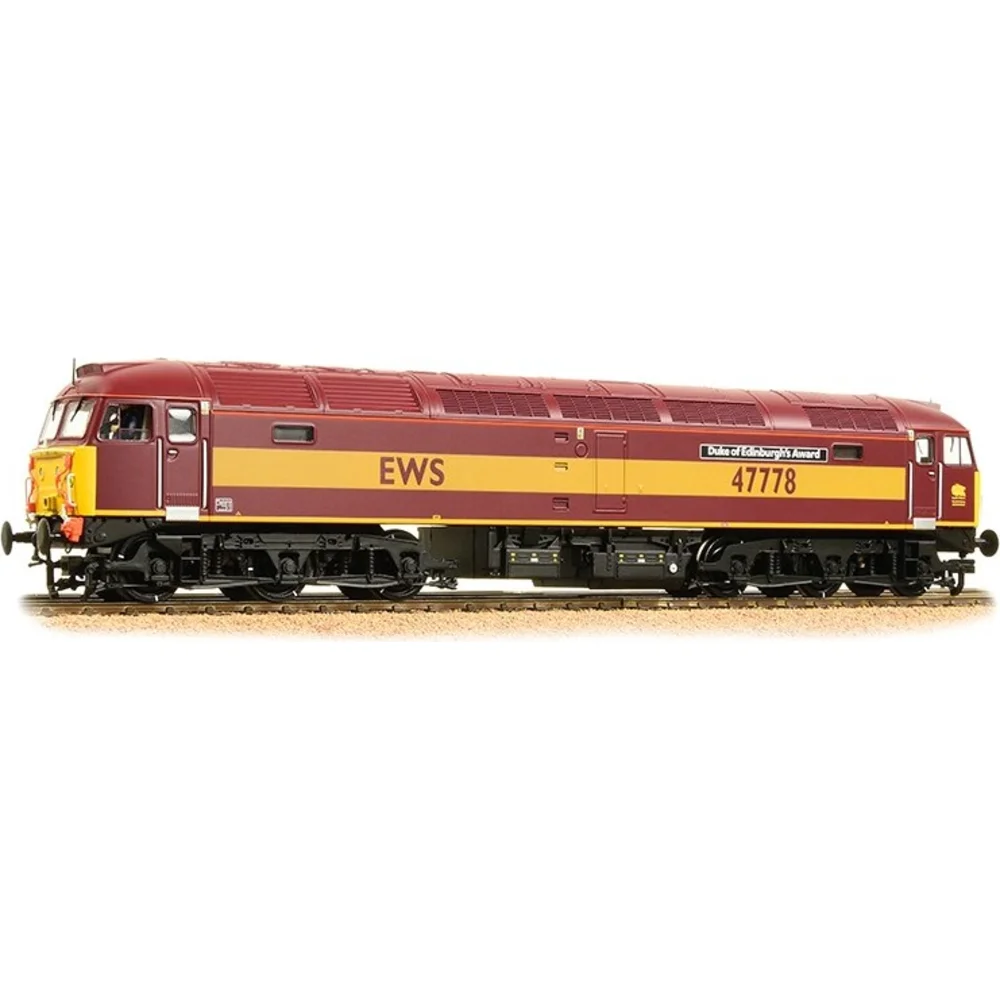Bachmann 32-817K
British Rail Class 47 47778 Duke of Edinburgh's Award English, Welsh & Scottish Railway Maroon & Gold
Class & Prototype
- Class: British Rail Class 47
- Traction: Diesel
- Transmission: Electric
- Built: 1962-1968
- Total Built: 512
- Running Number: 47778
- Name: Duke of Edinburgh's Award
The British Rail Class 47, or Brush Type 4, built 1962-1968, represents Britain's most numerous mainline diesel with 512 locomotives constructed by Brush Traction and BR Crewe Works. Despite early reliability problems, a mid-1960s decision to derate engines from 2,750 to 2,580 bhp transformed the class into Britain's most dependable mixed-traffic locomotive, achieving 55+ years service. Operating across all BR regions hauling everything from royal trains to coal hoppers, Class 47s wore over 30 distinct liveries spanning BR green through colourful sector schemes to privatisation colours. Currently, Bachmann and Heljan produce exceptional OO gauge models with motorised fans, ESU LokSound V5 sound, and 150+ detail parts, while Graham Farish dominates N gauge. With 32 preserved locomotives and continuing heritage operations, the "Duff" remains an iconic part of British railway heritage.
Operator & Livery
- Operator: English, Welsh & Scottish Railway
- Livery: Maroon & Gold
- Era: 9 - Privatisation
The English, Welsh & Scottish Railway (EWS) operated Britain's largest rail freight network from 1996-2007, controlling 90% of the UK freight market. Formed by Wisconsin Central through acquisition of five British Rail freight companies, EWS revolutionised British freight transport with 250 new General Motors Class 66 locomotives and distinctive maroon and gold livery featuring the famous "three beasties" logo. The company was acquired by Deutsche Bahn in 2007, eventually becoming today's DB Cargo UK while maintaining its freight market dominance.
The EWS maroon and gold livery was introduced in April 1996, with the first locomotive to receive the scheme being Class 37 number 37057, which emerged from Toton Depot on 25 April 1996 to coincide with the launch of the English, Welsh & Scottish brand. The colour specification featured maroon bodysides, roofs and ends with black underframes and buffer beams, standard UK yellow warning panels, and a distinctive gold stripe running centrally between the cab ends.
To ensure accurate colour consistency, a sample plate was flown from Wisconsin Central's American operations to Britain, where British paints were mixed to match this standard. Interestingly, when Class 66 and 67 locomotives were later built by General Motors, another sample plate was sent to the manufacturer, resulting in a slightly lighter shade than the original British mix.
The livery evolved through several variations. Early applications from April 1996 featured "EW&S" lettering (including the ampersand) in Arial typeface within the gold band. From January 1997, this was simplified to "EWS" with improved Gill Sans typeface - continuing a tradition established by the LNER in the 1920s and used by British Railways until the 1960s.
The gold band width varied by locomotive class - most received 600mm bands, but Classes 37, 58, and 73 looked better with 550mm bands due to their distinctive body shapes. Company lettering and locomotive numbers appeared in maroon within the gold stripe with 20mm clearance from the band edges, positioned at opposite ends on each side of the locomotive.
For model railway enthusiasts, specialist paint manufacturers like Phoenix Paints produce authentic colour matches, with their E.W.&S. Red (P193) and E.W.&S. Gold (P194) paints matched to original Wisconsin Central colour panels. Alternative options include RailMatch EWS Maroon (1255) which many modellers prefer for value and colour accuracy.
The EWS maroon and gold scheme became one of the most recognisable railway liveries in modern British history, remaining in use until Deutsche Bahn's acquisition in 2007 and the subsequent adoption of DB Schenker corporate red livery from 2009.
